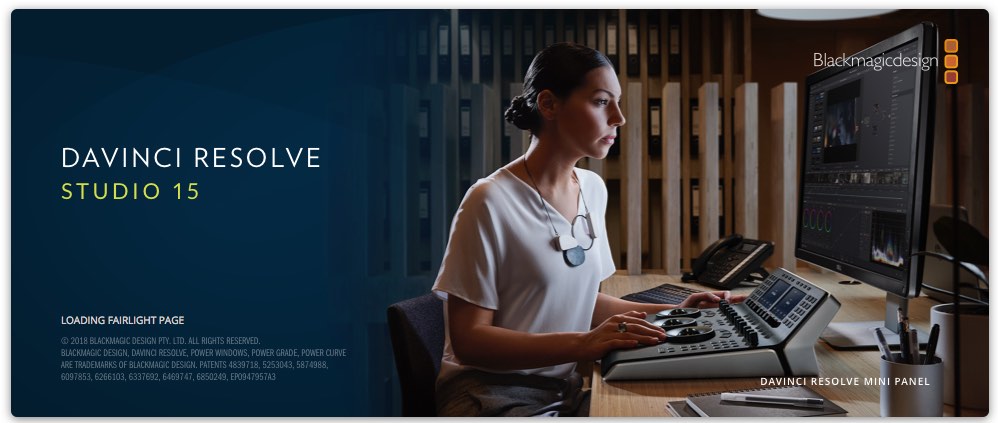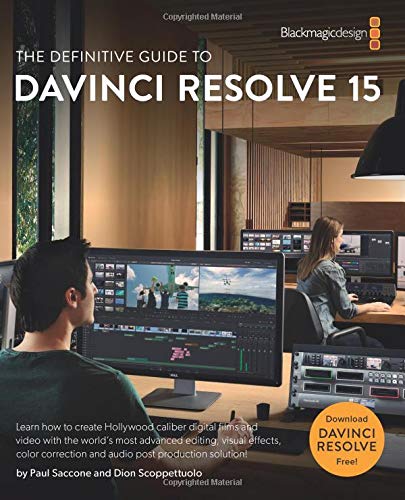DaVinci Resolve 15 Tips & Training
- The latest features in DaVinci Resolve 15
- Free DaVinci Resolve 15 Tutorials
- DaVinci Resolve 15 Tips and Tricks
DaVinci Resolve, the epic all in one editing, grading, audio mixing, visual effects creating behemoth is now officially out. In fact, I’m so behind the times (and BMD spit out updates every few weeks!) that the current version of the software is 15.1.1
My previous round up of DaVinci Resolve 15 Training was published in July with Public Beta 6 being the most recent version at that time, so check that out for more great resources.
The release of 15.1.1 is mostly bug fixes but also includes:
- Support for joining through edits in the Edit timeline from the context menu
- Improved playback performance when Selection Follows Playhead is enabled in the Edit page
- Support for scripting API to set output file name for rendering
The release notes for 15.1 aren’t short in themselves including new features such as:
Key new features
- Decoding Blackmagic RAW clips from Blackmagic Design cameras
- Audio ducking using side-chain compression in track dynamics in the Fairlight page
- Round tripping audio clips to third party audio processing applications from the Fairlight timeline
- IMF preset to generate Netflix IMF deliverables
- Creating and delivering supplemental IMF packages
- Photon validation of IMF packages
Fairlight
- Round tripping audio clips to third party audio processing applications from the Fairlight timeline
- Caching clips with FairlightFX and AudioFX
- Sub-bus and aux-bus routing in nested timelines
- Pasting and removing attributes to/from audio tracks
- Fairlight FX Soft Clipper
Fusion
- Creating and opening new Fusion compositions from the Media Pool
- Fusion composition generators in the Edit page effects library for creating comps without source media
- Loader nodes in the Fusion node graph
Edit
- Displaying clip marker annotations and overlays for the selected clip marker under the playhead
- Duplicating multiple selected timelines in the media pool
- Displaying the multicam angle name in the timeline, source viewer and the color page clip information
- Keywords in clip and timeline markers
- A marker keywords column on the edit index
- Exporting subtitle files in project archives
- Improved freeze-frame behavior to freeze the clip forward from the playhead instead of the whole clip
Color
- Support for ACES 1.1
- Accessing and selecting from multiple inputs for OpenFX nodes
- Improved behavior for the ResolveFX Warper plugin
The full details of what was included in the release of DaVinci Resolve 15 are far, far too numerous to include in this post, but you can read through them here, if you wish!
If you want to keep tabs on what has been added since NAB in April 2018, this forum post has it all.
Needless to say the entire process has resulted in a huge array of new features, improvements and increased integration of Fusion into Resolve.
Upgrade Tips
DaVinci Resolve tip of the day: If you are using OpenCL on macOS 10.12, would strongly recommend updating to 10.13 or 10.14. Seeing a lot of crash reports with OpenCL bugs which are resolved since then. Metal is also recommended on 10.13 and 10.14! #DaVinciResolve
— Rohit Gupta (@rohit_bmd) September 26, 2018
If you’ve been holding off on upgrading – make sure you back up those databases! – then these tips and guides should help you get up and running smoothly.
MixingLight.com have a comprehensive and free Guide to Safely Updating to DaVinci Resolve 15, including all the things to back up and export before you upgrade and other best practices.
Here are the headlines steps but you really need to read the full article to understand exactly how and why to do these things…
- Set aside time to do this properly & methodically
- Back up the computer
- Export projects and databases I’m going to upgrade
- Back up custom / 3rd party LUTs
- Export Power Grades
- Export Keyboard Shortcuts
- Begin the update routine (10 STEPS!)
- Re-install custom / 3rd Party LUTs
- Import Power Grades
- Rebuild (or Re-Import) Keyboard Shortcuts
- Get to work
Well worth a read in full here, before you get into trouble!
After almost 30 years of upgrading software, I’ve experienced it all. From catastrophic crashes requiring full Operating System re-installs to minor annoyances.
These steps have proven to be the most reliable method to ensure one thing: If the new software has a problem then it’s likely not the fault of how you’ve gone about upgrading the software. – Patrick Inhofer
Understanding Blackmagic Design RAW
So one big announcement from IBC 2018 was Blackmagic Design’s release of BMD RAW. A brand new codec and a free update to their existing camera systems via a quick update to the URSA Mini Pro (and likely the BMPC4K).
You can check out the official info from BMD here, and download some sample clips to try out for yourself. Be sure to download the DaVinci Resolve 15.1 update to get support for the format in post.
There is also a new standalone BMD RAW Player, which you can download for Mac OSX (only at this time), to correctly view the files outside of Resolve.
There is some debate as to whether RAW should be written as ‘raw’ (as it’s not an acronym), but the habit is that it’s capitalised, so I’m going to roll with that here.
If you want a better of understanding of what RAW is in the first place, this first video, above, from LumaForge’s Patrick Southern will fill you in.
Do I really need to always shoot RAW to always get the prettiest, most beautiful image for my production? And the answer is no. – Patrick Southern
In this second video from Patrick Southern of LumaForge, you can get a sprightly run down of the ins and outs of the new codec and what it means for production and post.
It’s worth watching to the end of the pros and cons and the comparison to other RAW codecs like RED RAW and ProRes RAW.
I assume going forward, CinemaDNG is effectively replaced by BMD RAW, although you should have the option to shoot in it.
If you prefer to read your way through all this new info then I’d highly recommend this post on NewShooter.com for that.
Using the Blackmagic RAW SDK means you get easy handling of all camera metadata such as lens information, iris, ISO, color space, and slate information.
Metadata is embedded directly into the .braw file. In addition, .sidecar files that contain fully editable and human-readable JSON formatted metadata can also be used.
What does Blackmagic RAW mean? It lets you shoot 4.6K RAW as if you were shooting UHD in ProRes LT.
3840×2160 ProRes LT – 51MB/s
4.6K BMD RAW 12:1 – 46MB/s— David Chapman (@DaveChap) September 16, 2018
More metadata, more controls and a lot of speed optimizations in the making for the new #BlackmagicRaw format soon to be seen in #AssimilateSCRATCH. @Blackmagic_News #BRAW #colorgrading #colorcorrection #Finishing #Dailies pic.twitter.com/Avd11o9lyZ
— Assimilate (@AssimilateInc) September 20, 2018
One of the big differences between BMD RAW and ProRes RAW is that Blackmagic have released an SDK for it which means that third party developers can incorporate it’s functionality into their apps. Just like Assimilate SCRATCH is doing. Apple haven’t done this yet, so for now it’s only available in FCPX.
It will undoubtably roll out to other apps, but it’s not happened yet.
Understanding ProRes RAW
Apple also recently released it’s own RAW codec called ProRes RAW. Caleb from DSLR Video Shooter has a three-part series of videos breaking down what it is, how to work with it and why you should care in the first place.
You can also read Apple’s official white paper on ProRes RAW here, and a short introduction here.
DaVinci Resolve 15 Training
Going through @hurkman Resolve 15 training. Tons of unsuspected features:
-transparency in compound clips
-replace with attributes
-Title+
-Linked move across tracks
And that just for editing!— Mathieu Marano (@ilovehue) July 23, 2018
If you want to get expert training on how to use every new feature in DaVinci Resolve 15, it’s tough to beat Alexis Van Hurkman’s new Ripple Training title; DaVinci Resolve 15 New Features.
Given that Alexis is both a professional colorist, author of the epic DaVinci Resolve manual, instructor on numerous tutorial series and the author of several colour grading books, he knows what he’s talking about.
Ripple Training were kind enough to give me access to it for an up-coming review, and as soon as I find the time, I’ll be sharing a few thoughts on it!
The course covers topics such as:
Check it out for yourself and watch some free samples on RippleTraining.com.
Anybody who wants a quick introduction to the DaVinci Resolve Fusion page should check out my “New Features in #Resolve 15” title from @RippleTraining. There’s a 45 minute walkthrough to get you started. Oh, and there’s hours of info about the rest of the new features, too…
— Alexis Van Hurkman (@hurkman) September 19, 2018
UPDATE – Feb 2019
If you want to learn how to use Fusion in DaVinci Resolve 15 then I’d highly recommend reading through this new post which reviews the introductory Fusion training from four of the big online providers; Mixing Light, Lowe Post, Ripple Training and FXPHD.
To my mind Lowe Post currently represents amazing value for money at under $5 a month!
There are also some excellent free resources, including downloads to all four of Blackmagic Design’s official training books (see below) – for free!
Check out it here: Learn High End Finishing Techniques in DaVinci Resolve Fusion
Original Post…
Speaking of colour grading training, I also recently reviewed filmmaker Noam Kroll’s new course on creating several creative looks from scratch, as well as learning how to use a systematic workflow for improving your grades.
It’s an enjoyable course and well worth a look. Check it out in more detail, along with a chat with Noam in this previous post.
Watching the class from start to finish will also give you a sensible structure for your own colour grading workflow; following an order of operations, establishing your base grade through foundational corrections and matching shots and then working through several different looks which ranged from highly stylised (with some really interesting results!) to more established blockbuster aesthetics.
Lastly in terms of Resolve training news it’s worth pointing out that Blackmagic Design have updated their official training book, ‘The Definitive Guide to DaVinci Resolve 15‘.
I’m sure much of the content will remain relevant in the coming months and years in terms of the apps functionality and feature set, although you have to wonder if a book is the best way to keep pace with the latest workflows and features in a piece of software that sees such relentless development.
If you’re interested it can be yours for the princely sum of [amazon_link asins=’0999391364′ template=’PriceLink’ store=’jonelwfiledi-20′ marketplace=’US’ link_id=’df7be9b1-c350-11e8-a6e0-490566bad0dc’].
It’s also available in Chinese, French, German and Spanish translations, which is nice!
DaVinci Resolve 15 Tutorials
I thought I’d kick off this part of the post with a couple of tutorials on the audio side of things in Resolve, something I should probably cover more often.
The first tutorial is from Yannick von Grabowiecki, and he talks you through using Resolve’s new ‘auto-ducking’ tools which helps to automatically drop the level of music under dialogue (for example).
Colorist Juan Salvo shares how to use the new audio mapping feature in Resolve (originally from version 14) to output masters using mix and submixed files such as 5.1 mono files.
If you’re about to export some master files from Resolve for the first time and don’t really know what you’re doing this would be worth the time!
Nicolai Waldman also has his own method for monitoring 5.1 mono files in Resolve, which he guides you through step by step in this short read.
Colorist Juan Melara is back with his LUT deconstruction magic, this time rebuilding the Kodak 2383 LUT as a DaVinci Resolve Powergrade. In the tutorial Juan walks you through how he did it, but you can download it for free from Juan’s site here.
As the download comes from Juan’s new store, you can pay as many, or as few, bucks as you’d like to in return for his expertise!
So you might be wondering why would you re-build a LUT that’s already available in Resolve?
The short answer is customisation. The Powergrade version gives you complete control over every single element. You are able to adjust and switch on an off individual nodes, depending on what you are after.
Speaking of LUTs, Avery Peck is back with part 2 of his detailed explanation of his LUT workflow, this time around focusing on using Creative LUTs in your work. You can check out Part 1 here (scroll to the last tutorial!).
Kevin Shaw from the ICA shares four tricks for manipulating Node Key: Output Gain to work with node opacity for better grades.
Sit in for a minute on one of Colorist and Trainer Warren Eagles grading classes and learn how to reduce the opacity of multiple nodes at once in this quick tip.
In a snippet from his most recent FXPHD colour grading training Warren shares how to make a DaVinci Resolve Archive file.
This will save all media, assets and projects files associated with the grading session. Great when a client has taken their hard drive away but you still need to make last minute changes to the original job.
I have previously reviewed Warren’s Colour Grading Creative Looks course (it’s excellent!) here.
In another tip recorded during Warren’s FXPHD training, he demonstrates how he likes to use multiple timelines to compare edits of the same project to check that newer versions have conformed correctly.
Alexis Van Hurkman is back with two DaVinci Resolve 15 tutorials for the on-going series Resolve in a Rush from Ripple Training.
In the first tutorial Alexis demonstrates improved sub-clip functionality including how to create sub-clips from your media with a simple drag and drop from the source viewer to the media pool.
If you drag from the timeline to the media pool you will create a duplicate clip, not a sub-clip.
In this tutorial Alexis shows you how to use new annotations tool to make notes on the screen notes during client review sessions.
Shift + Up/Down Arrow jumps through markers on your timeline. This functionality is (currently) only available in the Edit page, and not the Color page.
Just don’t write or draw anything you might later regret!
Justin Robinson from JayAre TV shares how to use the Curves and Vs Curves tools in DaVinci Resolve 15, useful for refining your grades.
https://www.youtube.com/watch?v=dgYLCNl03Ak
Dave Andrade from the PostColorBlog.com shares his thoughts on the new selection options in DaVinci Resolve 15 when making qualifications with colour tools like HSL isolations.
https://www.youtube.com/watch?v=335QBAwRDz8
Dave also shares three tips on speeding up your editing in Resolve, which focus on making and working with proxies, assigning colours to your clips for easy visual cues, and lastly working with stacked timelines.
As someone who uses Warp Stabiliser in Adobe Premiere Pro on a regular basis this comparison was intriguing. Often the default parameters for Premiere turn the image into visual jelly, but with a bit of tweaking you can often get decent results.
Dave walks through the differences and similarities between the two apps and how well and how quickly they can stabilise the same piece of footage. If you want to skip to the conclusion it’s at 7.54, but you’ll miss the point of the video if you do that!
I tracked a simple mask on a 4k clip in @AdobePremiere and @Blackmagic_News Resolve. pic.twitter.com/73sjEXBsfM
— Stu Maschwitz (@5tu) December 8, 2017
Fusion in DaVinci Resolve 15
Much of the work that has gone into the ten or so updates to DaVinci Resolve 15 since NAB in April 2018, when the Fusion integration was announced, has been around improving and enhancing that integration.
This first video from Colorist Juan Salvo delivers a great example of how to using the Paint tool in Fusion to do simple beauty work in Resolve. Juan says he’ll do a follow up tutorial in the future with a far more advanced way of performing this kind of clean up.
Juan points out that you need to use the ‘single stroke’ paint tool to be able to connect the effect to the tracker.
In this 73 minute conversation Tony Gallardo and Juan Salvo breakdown one of Tony’s composites to “learn all of his secrets” with an angle on ‘cross disciplinary’ learning.
There’s a whole category of tools inside of Fusion that, as someone who does vfx on a occasion and color and finishing most of the time, I don’t really dive into very deeply, because that’s not my background.
And I really wanted to get a walk through of this (comp) with you and get a sense of what these tools are and how you use them. – Juan Salvo
What I loved about this video is that it’s a great opportunity to sit over the shoulder of two creative professionals learning from each other and extract a ton of knowledge yourself! Well worth the time!
If you’re coming from After Effects and you want to move objects in the same way that you might have done with a null object, this tutorial from JayAre TV shows you how to do it in Fusion.
Justin has shared a substantial number of tutorials in the past few months, especially around Fusion, many of which you can check out in these previous posts:
In this longer tutorial Justin reveals how he makes complex looking motion graphics using the duplicate tool in smart ways in Fusion.
All of these things were built with the duplicate tool. The idea here is that we build one element and then we duplicate it and we add a ton of different parameters. – Justin
Casey Faris helps you get started with simple expressions in Fusion, just as you might in After Effects. Casey has a growing number of Fusion tutorials on his YouTube channel here.
Theo from MiesnerMedia demonstrates how to create a ‘Trapcode’ style dissolve effect in Fusion and supplies a free handy macro for you to download to get the job done in a jiffy.
Expect to see a similar market for Fusion marcos pop up, much like the market for LUTs exploded in the recent past.
In this follow up tutorial Theo shares how to actually install a Fusion macro in under 2 minutes.
Jamie Dickinson provides a quick walkthrough of some of his own work in Fusion 9 (the previous – and still available standalone app). What I found most valuable from this short tutorial was how easily he could replicate the effect on a completely different shot, re-using most of his existing node tree.
DaVinci Resolve 15 Twitter Tips
#Resolve15Tip: Do you have a messy, confusing node graph? Right-click and choose "Cleanup Node Graph" and Resolve will tidy things up for you #postchat #bmd #resolve #postproduction pic.twitter.com/Ju3m9MwAMd
— Chris Colton (@Chris_Colton) August 23, 2018
Chris Colton has been smashing it lately with some great dips on DaVinci Resolve 15, so these tips are pretty much a one man show.
#Resolve15Tip: Position Lock keeps clips at their exact time and track but still lets you change color, audio, trimming, and effects, unlike traditional locking. Command click the lock of a track or click the position lock symbol for the whole timeline #postchat @Blackmagic_News pic.twitter.com/UjJctljkvk
— Chris Colton (@Chris_Colton) August 12, 2018
Looks like this might only be working for clips that were originally Fusion macros in the Effects Library on the Edit Page – normal video clips lose Fusion effects when you drag them back into the media pool
— Chris Colton (@Chris_Colton) August 18, 2018
#Resolve15Tip: if you find yourself adding Fusion nodes and then always using the same settings again and again, right click on the node and go to settings and select save default. That node’s settings will become the new default for a node of that type #postchat #bmd #resolve
— Chris Colton (@Chris_Colton) August 19, 2018
#Resolve15Tip: Enable Live Save and all changes you make to the project will be saved as soon as you make them, in the background. New in v15 is automatic project backups at any chosen intervals that can be easily accessed in the Project Manager #postchat #davinciresolve pic.twitter.com/0ERhDRQc3O
— Chris Colton (@Chris_Colton) August 16, 2018
#Resolve15Tip: Enable Live Media Preview and any clip your mouse hovers over in the Media Pool will be scrubbed and displayed in the source viewer wherever you're scrubbing – playback keyboard shortcuts and marking ins and outs works too. Great for fast logging #postchat #resolve pic.twitter.com/pTh15lhP8c
— Chris Colton (@Chris_Colton) August 14, 2018
#Resolve15Tip: Hit Shift+D to disable/enable all color and/or Fusion effects in the viewer. Right-click this icon in the viewer, or go to View > Bypass Color and Fusion, to select whether color effects, Fusion effects, or both get bypassed by that shortcut #postchat #BMD #resolve pic.twitter.com/DBHsgLFI9y
— Chris Colton (@Chris_Colton) August 20, 2018
#Resolve15Tip: Assign "Append Node Graph" to a keyboard shortcut (^A for me), load a still or other grade into a memory, leave that memory selected and hit the shortcut to append it to the current clip. Works better than having to go click on a still every time then append it
— Chris Colton (@Chris_Colton) August 21, 2018
Organizing the PowerGrades.#DaVinciResolve #colorgrading pic.twitter.com/aFiAvuFkGI
— Mathieu Marano (@ilovehue) July 28, 2018
#Resolve15Tip: The Smart Cache is your new best friend, I like it so much that I'm making it a thread. The Smart Cache allows you to automatically render your timeline, in the background, to a playback-friendly, render-accelerating codec #postchat #bmd #resolve @Blackmagic_News
— Chris Colton (@Chris_Colton) August 22, 2018
Read the thread on this one.
#Resolve15Tip: If at all possible, place your Smart Cache on an SSD – the speed advantage over a normal/spinning hard drive is huge! #Resolve15 #bmd #postchat
— Chris Colton (@Chris_Colton) September 26, 2018
#Resolve15Tip: The Clone Tool copies any folder and all of its contents to any number of locations and then verifies (I use MD5), to make sure all files are completed and not corrupted. If you never download Resolve for any other reason, the Clone Tool alone is worth it #postchat
— Chris Colton (@Chris_Colton) August 9, 2018
#Resolve15Tip: Save any node as a Shared Node, then apply it to other clips. Changes to every instance of a Shared Node are rippled to every other instance, such as the node demonstrated here – see color temp changes in all camera 2 clips here #postchat #Resolve @Blackmagic_News pic.twitter.com/2mvl8G96Jp
— Chris Colton (@Chris_Colton) August 6, 2018
3. For Exporting pic.twitter.com/C8CkTaTN3R
— Twain Richardson (@twainrichardson) February 28, 2018
#Resolve #Colorgrading tip… The slightest of 'beauty work'… select skin tone and desaturate a bit then add the single colour it should be back in the gamma. This dude looks much healthier now.
— Jamie Dickinson (@dickij10) July 18, 2018









The IMF preset to generate Netflix IMF deliverables seems like a great feature, except that Netflix has to authorize you as a Netflix Preferred Vendor to use it. So, having the tool is only half the battle.
Or 1/3 the battle if you consider that you have to make the IMF well – and any supplemental IMFs have to be made well too. It’s tricky stuff and has to be done right.
I’m curious to give it a go and see if I can convince Netflix to let me make my own IMFs (ins tead of spending far too much to have someone else do it).